There’s ample legwork involved at the very beginning of developing an effective brand strategy that involves understanding what is already true. Having clarity around the reality that a brand exists within is key to setting the trajectory for where the brand can go. This clarity comes to life through the discovery then distillation of high-altitude insights that provide clear, guiding principles across several key categories, which we call Simple Truths.
What are Simple Truths?
Simple Truths represent the distilled essence of all findings during the initial phase of a brand strategy project. These insights are categorized into five main areas:
- Customer Truth: Insights into the customer’s needs, preferences, and behaviors.
- Cultural Truth: Understanding the broader cultural context and its impact on the brand.
- Market Truth: Insights into the market dynamics, trends, and competitive landscape.
- Business Truth: The core realities and principles governing the client's business.
- Product/Brand Truth: Key insights related to the product’s strengths, weaknesses, and unique selling propositions.
Each category is distilled into a single, overarching insight, backed by a series of supporting insights derived from the comprehensive findings during the beginning of a brand strategy initiative.
Why are Simple Truths important?
The primary purpose of identifying Simple Truths is to focus the strategic work that follows. By understanding and articulating what is already known—gleaned from cultural trends, market research, client interviews, competitive analysis, and customer feedback—we can identify key opportunities and challenges. Simple Truths ensure that all stakeholders are aligned, providing a clear and shared foundation for the brand strategy.
When shared with clients, Simple Truths facilitate alignment among all parties involved. They help ensure that everyone has a mutual understanding of the core insights that will govern and guide the subsequent phases of the project. This alignment is crucial for a cohesive and effective brand strategy.
How are Simple Truths developed?
The process of developing Simple Truths involves several key steps, from gathering our findings to creating insights from those findings and, ultimately, our Truths. However, it is important to first determine the difference between findings and insights.
Simply put, findings are commodities. They represent raw data collected from various sources—ranging from primary and secondary research to available customer information. This data is widely accessible, meaning that if someone else is conducting a similar search, their findings will likely be similar to ours. Findings are something that anyone, from our client to a major competitor, can obtain, so they don't typically serve as the foundation for unique or groundbreaking work. Findings are found.
Insights, on the other hand, are created. Insights involve synthesizing findings to discover patterns that are not immediately obvious. They inform meaning and reveal the emotional undertones hidden within the data. When done correctly, this process allows us to tap into a deep understanding of the truths and desires of the zeitgeist.
As we go about the process of transforming findings into insights for the development of our Simple Truths, AI tools can be a powerful ally, especially when it comes to gathering findings, testing and challenging our hypothesis.
The steps toward developing Simple Truths are:
- Gather findings: The first step is to collect information from various sources. This includes desk research on the market and category, client stakeholder interviews, competitive landscape analysis, previous customer research, and insights from the client's product, sales, and service teams. AI tools can help here by distilling category trends, competitor information and even helping to draft stakeholder interviews.
- Categorize findings: Once the information is gathered, it is organized into the five main categories corresponding to the truths.
- Create insights: For each category, 3-5 key insights are developed based on the patterns and emotions running through the findings. During this phase, AI tools can help in testing our insights and hypothesis against what's expected or cliché in the category.
- Synthesize into Truths: Finally, key insights are further synthesized into one overarching insight, or “truth” for each category. This synthesis represents the cumulative understanding derived during this first phase of work. Those truths, starting with customer, should create a red thread of meaning that the brand must work within.
Building a brand strategy with Simple Truths
Simple Truths provide focus for the strategic work that follows. They ensure all stakeholders have a shared understanding of the core context and “truths” of where customers, the market and the brand sit today.
Clarity, focus, and alignment are essential for a successful brand strategy. Simple Truths help get the foundation. By understanding and agreeing on the core “truths” or meaning that is governing the customer’s life, the market, and the brand, you can develop a more resonant brand strategy that all stakeholders can rally behind.





